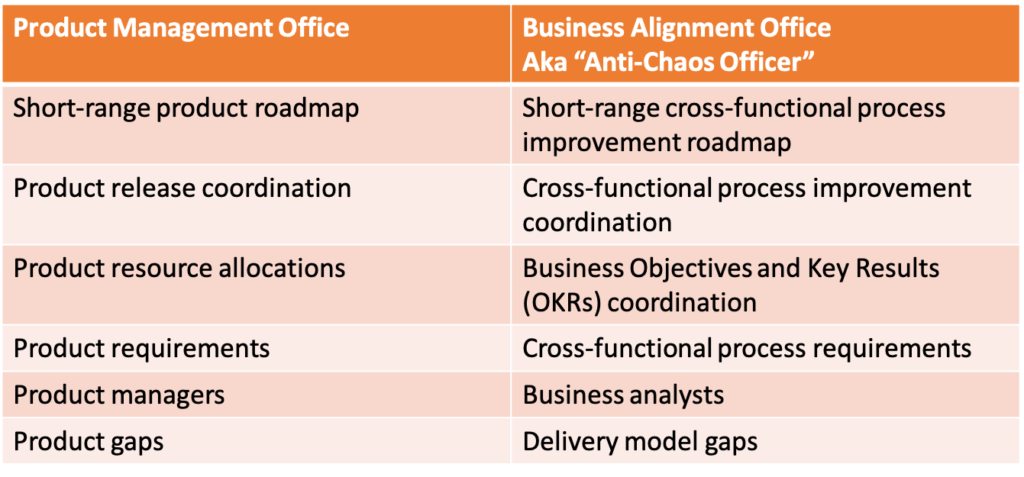Summary Insight:
Your company’s biggest execution gaps live between the gears—functions not talking, data not shared, chaos growing. This article shows how an Anti-Chaos Officer fills the gaps.
Key Takeaways:
- Most friction and waste live in the white space between functions—not within them.
- A Business Alignment Officer, led by a data-driven influencer, cuts through cross-functional chaos.
- Don’t bury this role—elevate it, structure it correctly, and let it drive continuous improvement.
Does your business need an anti-chaos officer? And what in the heck is an anti-chaos officer anyway? I’m referring to a senior leadership role that is dedicated to reducing the internal friction, noise, and chaos that naturally emerges across and between functions and whose mission is to enable the entire business to execute faster and smarter as a whole.
This role goes by many different names and interpretations and is usually splintered across multiple organizational functions. As a consequence, even though it can deliver tremendous value and leverage, it is still widely misunderstood. Additionally, the need for it is unrecognized in most businesses today. I am dedicating this article to clear up these misconceptions and to help you design and implement this very impactful position in your business. You’ll be very glad that you did. Let’s get to it.
What is this Anti-Chaos Officer Role Exactly?
Half the battle of understanding this role is defining it. Seriously. It is usually fragmented across the organization and comes in many different flavors and job titles. In my organizational structure work, I usually call this the Business Alignment Office. But this term hasn’t really helped me to make this position easier to communicate and teach. I recently heard a recruiter tell one of my clients, “Oh, it’s like an Anti-Chaos Officer!” and I laughed at the clever angle, which is what inspired me to write this article. Sometimes this role gets conflated with a Program Management Office or even a Project Management Office but it is more than these. Obviously, a role like a Chief Operating Officer or an equivalent has elements of bringing order, stability and throughput to the organization, but that isn’t the role I’m describing either.
So what is it? This is an organizational linchpin role that drives the coordination, management, and execution of all major cross-functional processes, projects, and initiatives. Its purpose is to identify, plan, coordinate, and communicate those high-impact, cross-functional problems and initiatives that improve metrics and decision-making, accelerate throughput, improve quality, and enable scalability of the entire organization. Its #1 mandate is to seek out cross-functional entropy and — by working together with other impacted functions — bring forth shared insights, speed, quality, and performance. Then find the next cross-functional opportunity and repeat.
When I was the CEO of Commission Junction, I blindly stumbled into this role and quickly realized the positive impact it can have. At the time, I was fortunate to have on staff a very smart and talented individual named Wade Crang. Wade had an MBA and an advanced math degree and had worked for several years has a consultant at a Big 5 consulting firm. I remember hiring him even though we didn’t really have a well-defined role for him to perform at the time. We just liked him and could tell he was smart and highly motivated.
Wade had a natural affinity for data and a deep curiosity to seek out and discover where the organization could save time and money and do things better. He didn’t focus on one area but looked across at the entire business for the low-hanging fruit to pick. He had one direct report underneath him, a business analyst, and that was the extent of his department. I basically left them alone to their own interests and initiatives and didn’t expect too much positive impact. I was quickly proven wrong. Within just a few weeks, we began to see friction and problems areas that had persisted in the gaps in between functions (e.g., between sales and operations, for example) start to go away and more momentum and free cash flow fall to the bottom line.
Three things stick out to me about Wade’s role and his approach. One, he always started with the data first and made sure that there was an accurate baseline established as to what was happening in the business before he did anything. Two, he never forced himself into another department. He always presented the data to the impacted departments and offered his help. But if they wanted his help, he had to be invited in. Three, he always shared the results and the learnings from these cross-functional initiatives, good and bad. Example: “Our average time to onboard over the past 6 months was 72 hours. We (myself, the sales leader and customer success leader) had a hypothesis that we could get it to 50 hours by changing these steps in the customer onboarding process. As of now, we’re at 48 hours, resulting in $400K in new monthly MRR this year.”
That’s the spirit of this role. Find the friction points and delivery model gaps that exist in between other functions and then take a data and business process optimization mindset to reduce entropy and increase throughput, quality, and bottom-line results. Then repeat in a cycle of continuous improvement.
In my organizational structure and design work, I have seen that the success and impact of such a business alignment role can make, time and again. But honestly, too few of my clients prioritize this role to the extent they should. I think part of the problem is my inability to give it a clean title. After all, it’s easy to go to the recruiting market to look for a qualified Chief Operating Officer or a head of Program Management. There’s tremendous shared consciousness on what these more commonly understood roles do and look like. It’s not nearly as easy to define a head of a Business Alignment Office or an Anti-Chaos Officer (to quote that recruiter who was also struggling to give it a sexy title). Nevertheless, this role I’m describing is just as critical and can create tremendous return on the investment.
What this Role is Not
Sometimes the best way to understand what something is, is to define what it is not. In this case, this role is NOT accountable for product management, operations, fulfillment, customer success, or other major organizational functions. Instead, it is accountable for the design and optimization of “the work that supports the work,” especially the workflows that cut across different functions like Sales, Product Management, Manufacturing, Engineering, Fulfillment, and so on. In other words, it does not manage Product, Operations, or Fulfillment teams, projects, or engagements directly but works with other functions to optimize how you execute as an entire organization.
Look at the image of the gears above and note the gaps that exist between them. If each gear represents a different organizational function like Sales, Operations, and Fulfillment, then this role is accountable to sniff out and close the gaps between gears. It is such a critical role because chaos or entropy naturally emerges in the dark areas that exist between different functions, and if left unaddressed, it will only increase over time. This role is accountable to find those problem areas, bring them into the light, and to help the impacted functions to resolve them together. This will move the organization forward so that each turn of the gears gets better and faster.
For example, let’s say that there’s a breakdown in the time between when the organization invoices customers and when it collects. Who is accountable for this breakdown? If you were to ask Sales, they would tell you it’s the Accounts Receivable department, which isn’t generating the correct invoices in a timely manner. But if you were to ask Accounts Receivable, they will tell you the problem lies within the Sales team, which isn’t following the defined setup and invoicing process.
As you know from experience, the correct answer probably lies somewhere in the middle, right? The Sales team needs to follow the accounts receivable process but that process can probably be highly simplified and optimized. The Accounts Receivable department needs to be accountable for the receivables balance but also needs help from Sales to influence collections from key accounts. If you were to attempt to solve this problem without a third leg of the stool that can understand the data, look at the problem from a holistic view, and catalyze Sales and Accounts Receivable to design a new and better process together for both sides, the problem will likely remain and chaos will reign.
Therefore, the purpose of this role is to seek out those problem areas or breakdowns that exist in between functions, bring them to light, galvanize a response, then measure progress and share the results. Put another way, if one of the reasons of having an organizational structure is to create unarguable accountability for different business functions (and it is), then this role acts as a scanner and sweeper to ensure that problems and opportunities aren’t lost in the gaps between functions.
The Approach of a Successful Chief Chaos Officer
You may be asking, if this anti-chaos role isn’t actually accountable for functions like Product, Operations, Fulfillment, etc., then how can it possibly bring down the chaos that exists within and between these and other functions?
The answer is all in the approach! Just like Wade, the leader of this role must rely on data and influence vs. authority and control. It can’t force its way in to solve others’ problems. It can’t take on the accountabilities of other functions. It has to demonstrate its value by leading with data, working across, modeling and sharing success, and offering to help.
In addition to hiring or promoting the right skills and style of the individual to lead it, the best way to launch this role into the organization is to have the leader create a digital war/data room. They’ll spend the first 3 to 6 weeks interviewing other functions on their frustrations and opportunities for improvement, specifically in cross-functional breakdown areas.
This is important! While this role may have the expertise to help Manufacturing with its manufacturing process, it is much better to help streamline the process in between and across Manufacturing and the rest of the organization — for example, between Manufacturing and Engineering or between Manufacturing and Finance or Sales, or wherever the breakdowns are occurring. If it dives deep into the Manufacturing process itself, then it’s going to spend the next several quarter/years, optimizing manufacturing only. But what if the Manufacturing function is sucking eggs and actually needs tremendous help? Then it probably needs a new head of Manufacturing and/or the support of dedicated manufacturing specialists. In other words, Manufacturing needs to own its own internal manufacturing process, just as all other functions need to own their own internal processes and metrics.
There are three guidelines that I always teach a new head of Business Alignment:
#1: Never take on a project that doesn’t have baseline data. You must be able to measure both pre- and post- implementation, or simply don’t do it! If your business is in a data quagmire and can’t easily get or extract data, then you might assign a dedicated business analyst with coding skills who can work around the obstacles until you have a full-fledged data warehouse and analytics. Don’t be alarmed about giving a few engineering or analytics resources to the Business Alignment Office. It will never have a large team. Just a small cadre of smart people who are data-, business-, and process-savvy and who are dedicated to helping other functions close the gaps. The resources you invest here will more than pay for themselves. If not, then there’s either no room for continuous improvement (impossible), the growth strategy isn’t putting enough pressure on the system to evolve, or you’re doing it wrong.
#2: When getting started, always look for quick wins. Meaning, don’t take on 3 or 5 projects at once and allow yourself to get bogged down in a quagmire. Instead, choose 1 short-range project and knock that out of the park. Then share the results with the entire organization and give lots of credit to those functions and people who were involved. That will start to build shared consciousness across the rest of the organization on what this new role does and the impact that this office can bring. Basically, don’t try to herd cats. Open a can of tuna and watch the cats come running. You can consider taking on longer term initiatives only after you have established the purpose and impact of this office.
#3: Always be fully transparent. Publish what potential projects are at the top of the queue. Actively share results and learnings, both good and bad. Make it the problem of the other business leaders to get your attention and change the priority in the queue because of the business ROI potential. If they make a strong business case, then their project gets priority, but that means other projects have to drop in priority. Meaning, I want you to have a mindset of full transparency and execution. Drive results. Share the results. Then repeat. Don’t become a bottleneck that is trying to digest and process a host of different projects. Also, don’t take on doing the work that is the accountability of another function. Focus on improving the throughput and quality in between functions.
Where to Place this Function in the Organizational Structure
I recommend you place the anti-chaos or Business Alignment function as a peer to the other major functions in the structure and as a direct report to the CEO. Why? Because this role is relying on influence and data to work across the organization. If you bury it as a project manager within Operations, for example, then it is going to be operations-centric and won’t be seen as a catalyst to other functions. In such a structure, it can even be seen as a stool pigeon that is just there to implement the will and needs of Operations, not to understand and help other functions like Sales, Customer Success, Finance, Marketing, etc. By keeping it a peer, you keep the interdependency.
Even if you are running a more consolidated structure with a span-breaker like President & COO in place, you still need to activate this Business Alignment role in the structure. It just can’t be buried under Operations or another major function if it is going to work across the organization and make the impact it is capable of.
If you’re already familiar with the Organizational Physics approach to Product Management, then one way to conceptualize this role is as a complementary twin to the Product Management Office in the structure. Basically, Product Management is the role accountable for translating, prioritizing, and coordinating new short-range product development and releases. Just as Product Management is to product, the Business Alignment Office is to the rest of the business.
Put another way, every organization needs at least two legitimate linchpin roles if it is going to thrive over time: one on the product side (Product Management Office) and one on the business side (Business Alignment Office). Basically, they are two sides of the same coin. Both roles can have a similar style, approach, and mindset to work across the organization and set priorities, but they require very different skills, career experience, and knowledge. In the chart below, note the importance that I’m placing on cross-functional coordination in the Business Alignment Office:

Why OKR Management is Placed Here
You may be asking why I’ve placed Objectives and Key Results (OKRs) Management under this function. The reason is that OKRs have a very high level of cross-functional interdependency and they are about moving the business forward and creating up-lift (versus business as usual). Therefore, the management or support of OKRs fits very nicely into this role—not to mention that the leader of this function needs to understand all aspects of the business from a cross-functional or holistic view.
This does not mean that this role is accountable for the execution of other departments’ OKRs or for approving their OKRs. Approving OKRs is always the accountability of the CEO or business unit head. The Business Alignment Office role is there to support the CEO or business unit head in the planning, tracking and retrospectives of the OKRs.
This is not a Project Management Office
One trap this role can fall into is to become a centralized project management office that is tracking, reporting and troubleshooting on a host of different projects across the organization. While your business may need a centralized project management team, don’t allow this function to get swamped under general project management tasks. This is NOT an administrative role. Instead, set it free to find those high-leverage, cross-functional improvement opportunities that reduce entropy and make the work better, smoother, and easier for everyone involved.
What is the Best PSIU Style for this Role?
I usually code the desired PSIU style for this role as a Stabilizer and Unifier or a pSiU which means that it excels at bringing order out of chaos and working well across the organization.
However, you will find more candidates, and may even feel better yourself, by having a higher Producing force in this role. The Producing force is that high-energy force that focuses on the short-run tasks and busts through obstacles to deliver results. It certainly seems like there is a need for a higher Producing force in this role, so why don’t I code it that way, as a Producer-Stabilizer-Unifier style?
The reason why is that a strong Producer style in this role will tend to create fast results but at the cost of stepping on a lot of toes and creating internal resistance to its presence. Basically, you want a healthy Producing force in this role, but not so high that it can’t work across the rest of the organization well or that it dives in to fix others’ problems for them. You need this role to galvanize awareness and initiative so that other functions can participate in solving their own challenges. You don’t want this role to become a one-man superhero who jumps in to save the day and then gets burned out from the effort and political fallout.
What is the Actual Job Description?
Great question. I’ve created one for you. Feel free to copy and modify it.
Where to Find Qualified Candidates
Qualified candidates are actually easy to source. Look for really high IQ with enough EQ to work well across the organization. MBAs with experience in Big 5 Consulting, data analytics and process improvement can often be ideal. As I mentioned, look for a Stabilizer-Unifier style and with enough Producing force to get after it, but not so much that it creates more organizational entropy.
As I mentioned, the real challenge that I and the CEOs that I coach have with this role is what to call it. And especially what to call it in the recruiting market. I hope it is obvious that I used the term “Anti-Chaos Officer” to grab your attention and that hopefully I’ve inspired you to start to think about the impact this role can make and where and why you need it. But I don’t think you can go to the recruitment market looking to fill for an “Anti-Chaos Officer.” Maybe I’m wrong.
So what do you think I should call it? I’m definitely open. I have called it the Business Enablement office at times but now I’m leaning towards Business Alignment Office. Program Management Office (PMO) is too bureaucratic and doesn’t quite capture it. Business Operations is too operationally oriented. Business Integrator is a loaded term but maybe it works. Seriously, I would love to find the perfect title! :-/
How to Measure the Success of this Role
If the leader of this function has approached things in the right way by leading with data and establishing a baseline, measuring performance, being transparent, and working across, then it’s drop-dead easy to measure the performance of this role. The numbers and ROI will be right there for every project. If they haven’t, then it isn’t easy to measure success at all. Just another reason to reinforce approaching it in the right way.
One thing to keep in mind is that this is indeed a full-time role. Its job is never done. You don’t launch this role to complete one or two key cross-functional projects and then end it. There is always room for continuous improvement. There is always chaos to manage. If you want something to improve in your organization, have the right role accountable for it and keep striving to get better with each iteration.
Summary
Despite not having a perfect title for this role yet, I hope that I’ve communicated the essence of it and the sustained value it can bring to your business when approached in the right way. While the value will show up on the top line and bottom line, if done correctly, it will also show up in how the entire organization learns and evolves.
If you don’t have this role in the organization, or you have it buried too deeply under other functions, elevate it! Give it a charter and watch what happens. It’s only after having it in the organization for a month or so that the light bulb will finally turn on. When you hear yourself saying, “Ohhh, now I get it. This is what that guy Lex from Organizational Physics was talking about! I wish I had done it 3 years ago,” just know that I’ve heard that before!
Finally, two books besides Organizational Physics that I assign to all CEOs and new leaders to understand this role are Black Box Thinking by Mathew Syed and the High Velocity Edge by Stephen J. Spear. Black Box Thinking reinforces the need and mindset of measuring everything and using the data to solve problems, not casting blame. The High Velocity Edge is great primer on the mindset for continuous improvement, showing that we learn best when we get to experiencing the problem ourselves and then self-discover the solution. These are both essential skills for building a learning organization that gets better over time.




